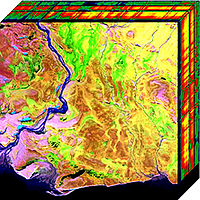
Photo from wikipedia
Monitoring the quality attributes of grapes is a practice that allows the state of ripeness to be checked and the optimal harvest time to be identified. A non-destructive method based… Click to show full abstract
Monitoring the quality attributes of grapes is a practice that allows the state of ripeness to be checked and the optimal harvest time to be identified. A non-destructive method based on hyperspectral imaging (HSI) technology was developed. Analyses were carried out directly in the field on a ‘Sangiovese’ (Vitis vinifera L.) vineyard destined for wine production, by using a Vis/NIR (400–1000 nm) hyperspectral camera. One vineyard row was analysed on 13 different days during the pre-harvest and harvest time. The soluble solids content (SSC) expressed in terms of °Brix was measured by a portable digital refractometer. Afterwards, the grape samples were split in two classes: the first one composed by the samples characterised by a °Brix lower than 20 (not-ripe), while the second one by the samples with a °Brix higher than 20 (ripe). Grape mean spectra were extracted from each hyperspectral image and used to predict the SSC by partial least squares regression (PLS), and to classify the samples into the two classes by PLS discriminant analysis (PLS-DA). SSC was predicted with a R2 = 0.77 (RMSECV = 0.79 °Brix), and the samples were correctly classified with a percentage from 86 to 91%. Even if the number of wavelengths was limited, the percentages of correctly classified samples were again within the above-mentioned range. The present study shows the potential of the use of HSI technology directly in the field by proximal measurements under natural light conditions for the prediction of the harvest time of the ‘Sangiovese’ red grape.
Journal Title: Biosystems Engineering
Year Published: 2021
Link to full text (if available)
Share on Social Media: Sign Up to like & get
recommendations!